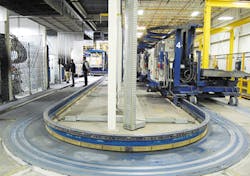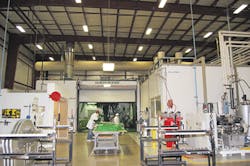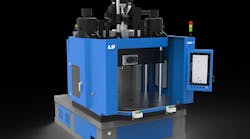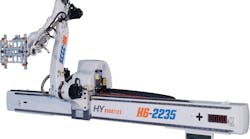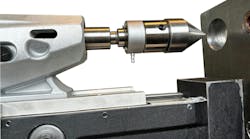With robots for painting and a unique rotary carrier system for moving presses and molds, molder Romeo RIM has primed itself for success through automation.
The company specializes in thermoset reaction injection molding (RIM). Robots play a significant role, especially in the company's automated long-fiber injection (LFI) molding operations, performed by two KraussMaffei systems, including the rotary carrier system and a double-shuttle mold carrier system.
The Romeo, Mich., plant is committed to automation, President and CEO Tim Howell said. "Robots are our lifeblood in manufacturing, especially with the LFI process. We have robots for painting and for applying the urethane systems, so every single innovative idea we're looking at to help us be faster, lower costs and get better seems to involve automation."
Romeo RIM produces composite parts for buses, heavy trucks, spas and agricultural and construction equipment. Its clients include John Deere and AGCO in the agriculture and construction markets; New Flyer and Prevost, a division of Volvo, in the transportation market; Utilimaster, Daimler and Volvo in the heavy truck market; and Watkins Manufacturing and Jacuzzi in the hot tub market.
The company uses primarily PU and dicyclopentadiene (DCPD) resins in its products. Though the resins can form parts that are several times larger than those made by compression or traditional injection molding, they are just as strong, stable and aesthetically appealing. In cases where a client wants to lightweight a product, the resins can be foamed. Or the chemistry can be changed so that the final product, such as a bumper, exhibits a high degree of energy absorption.
LFI materials are applied in an open-pour process where the chemicals and glass are mixed outside the tool and dispensed into an open mold that closes after the shot is applied into the mold cavity via a robot.
UNIQUE ROTARY CARRIER SYSTEM IS KEY
Romeo RIM has 16 molding centers, three paint and prep work centers, five trim centers and three assembly and packaging work centers. The centerpiece of its innovations, though, might be its fully automated rotary carrier system from KraussMaffei.
As part of the company's LFI operations, seven presses ride on carriers around a 100-foot oval track. As they travel on a rail, the presses make stops at four stations, where robots apply paint and resin to the mold. As each press nears the completion of its loop, the mold closes on the resin, forming a part; the cycle then begins anew. The system allows the company to make seven unique parts at one time.
The rotary carrier system is about the size of a hockey rink, and it is kept behind a protective fence.
Howell described the system as state of the art. KraussMaffei originally developed it for another company that was making 8-foot-by-3-foot door panels. However, when the original owner shifted its strategy, Romeo RIM recognized an opportunity. Romeo RIM purchased the equipment and installed it last year to manufacture parts via LFI — a growing segment.
"We pulled it out of their facility, sent it to KraussMaffei and basically rebuilt the whole system," Howell said. "We updated every critical component down to the wheels on the carriers and the pumps on the injection units. We basically did a thorough refurbishment and rebuild. Then, we designed in new custom features to augment our process and products. … It's basically a brand-new piece of equipment. When it came in here, we added in-mold paint capabilities. We upgraded the control systems and upgraded the wireless communications system on it."
Designed to accommodate molds measuring 4.5 feet by 9 feet or smaller, the presses can cover up to 15 feet per minute over the track, which means the system can deliver a molded part once per minute. Four-hundred-eighty-volt electric motors power the presses' movement around the track.
Wi-Fi transmitters on the carriers allow the system to track the position of each press, so that the actions taken at each station are appropriate.
The first stop for an empty mold is the painting station. A Fanuc P-250iB robot with a reach of about 9.8 feet, a 33-pound payload and an R30iB controller paints the inside of the mold. The robot is equipped with an ATI QC-21 quick tool changer, which allows it to select different color paint sprayers. The robot can mask one area while painting another area, allowing it to use two separate colors.
Romeo RIM uses two Graco ProMix PD2K systems for mixing custom colors for application by the robot so it can paint any of six colors on each carrier. The Graco system supplies these six colors of paint independently so that all color changes are completed off line, without slowing cycle times.
The in-mold painting system allows the color to become chemically bonded to the finished PU product, so that it adheres better and is less likely to chip, company officials said.
After leaving the painting station, the press moves down the track to receive a barrier coat. The barrier coat, consisting of a PU material, protects the painted surface from the glass fibers that will be sprayed on later. A Fanuc R-2000iA robot with a reach of about 9.8 feet, a 275-pound payload and an RJ3iB controller applies the barrier coat.
The press then moves to the third station. There, two ABB IRB 6600 industrial robots — each with a 9.8-foot reach, 440-pound payload and an IRC5 controller — spray on a mixture of PU and fiberglass.
"We are mixing two liquid chemicals together, but we are doing it on a spray unit that is on a robot," said Matt Getty, VP of business and product development.
A robot equipped with a mixing head that contains a chopper unit cuts fiberglass rovings in lengths of about 0.5 inch, mixes them with the PU material and sprays the mixture into the cavity of the mold.
Depending on the application, Romeo RIM has the option of foaming the resin to reduce part weight.
"Because the chemistry we use for the LFI process is a polyurethane, we have the ability to foam that resin system," Getty said. "One of the big benefits, depending on the markets, typically transportation, is that we provide a lot of lightweighting but still provide really high mechanical properties for part stiffness without sacrificing other key part properties."
The molds remain open throughout most of their circuit around the track. Painting takes place in closed booths. Once the fiberglass-PU mixture is sprayed into the mold, eight hydraulic cylinders apply 100 tons of pressure to close the mold. The material cures while the mold moves to the operator's station, where an employee removes the molded product and prepares the mold for another cycle.
"It is a low-pressure molding process," Getty said. "The internal pressure of the mold when it is forming the part is significantly less than, say, an injection molded part or a high-tonnage or a high-pressure molding, like an SMC [sheet molding compound]. What that means for us is that we do not always have to use a steel mold to withstand those molding pressures. We can actually get along with aluminum molds. We can actually form parts for prototype purposes or very low-volume parts out of epoxy molds, as well, because that molding pressure is so low. That helps in keeping the cost down for a customer."
After the parts are removed from the molds, the excess plastic is trimmed by hand.
Using the rotary carrier system has reduced the cost of manufacturing molds fitting the 4.5-foot-by-9-foot presses. With it, mold changes can now take place offline. When a mold needs to be changed, the press travels onto a separate track that's attached to the oval. There, an overhead crane can swap out the mold.
Among the major customers for LFI products made on the rotary carrier system are spa manufacturers, which are seeing increased demand for their products, the company said. The presses turn out panels used underneath hot tubs.
Getty said the addition of the rotary carrier system has expanded the company's capabilities.However, Romeo RIM said it could use the rotary carrier system to make other goods, as well. Some other applications include the production of body claddings and closures and side panels for industrial vehicles.
Each of the seven carriers on the rotary carrier system includes two Sterling temperature-control units (TCUs) to regulate the temperature of the molds throughout the process. In addition, each of the carriers has a 5-gigahertz wireless communication system that allows the system to communicate the status and location of each carrier.
Romeo RIM also installed Aquatherm TCUs from Thermal Care to control the temperature of the PU components that are sprayed onto the molds.
Turbo Spray, a Howell, Mich., firm specializing in integrating paint spraying equipment, developed a controller that allows the Graco paint mixing system to communicate with the Fanuc paint robots and KraussMaffei rotary carrier system.
LFI DOUBLE-SHUTTLE SYSTEM GETS BOOST FROM AUTOMATION
The rotary carrier system augments an older double-shuttle mold carrier system from KraussMaffei that accommodates molds as large as 12 feet by 12 feet. It was put into service in 2011.
Like the rotary carrier system, the LFI double-shuttle mold carrier system is highly automated. However, instead of operating on an oval, it is oriented lengthwise, with pairs of painting robots and LFI robots arranged around two presses in the middle.
First, two ABB IRB 5400 robots with a 9.8-foot reach, 55-pound payload and IRC5p controllers apply paint to the molds. The robots are equipped with ATI QC-21 quick-change tooling for paint gun and barrier coat changeovers.
Next, two ABB IRB 6600 robots with a 9.8-foot reach, 440-pound payload and IRC5 controllers apply the fiber and PU mixture. The molds then go into one of two central 400-ton KraussMaffei hydraulic shuttle presses. After curing, the molds are opened and the parts are removed by operators.
Romeo RIM made a significant investment in its LFI equipment over the past two decades, becoming a leader among U.S. plastics processors, Howell said.
"Our culture of innovation and continuous improvement have led us to relentlessly make modifications and improvements so that the equipment becomes more valuable over time. We have a systematic process that allows us to bring ideas up at all levels of the organization, then execute them in an efficient process to ensure the innovation is realized in a timely manner."
While Romeo RIM's latest upgrades involve its LFI process, the company produces a variety of parts using a multitude of processes. This includes 80-pound DCPD Class 8 air deflectors, and elastomeric PU bus bumper assemblies, as well as 35-percent fiberglass-reinforced panels for agricultural equipment, Howell said.
Automation will continue to guide the company's decisions, Howell said.
"We're looking at automated trimming techniques. We have gone as far as we can with manual trimming. This past year, we did quite a thorough analysis to determine what is the best trimming technique. The next new innovative process is going to help us here at Romeo, and also allow us to help our customers," he said.
"We're also looking at robots to help us demold and move parts throughout the process. For us, automation is going to be a big driver in the future."
Bruce Geiselman, senior staff reporter
Contact:
Romeo RIM Romeo, Mich., 586-336-5800,


